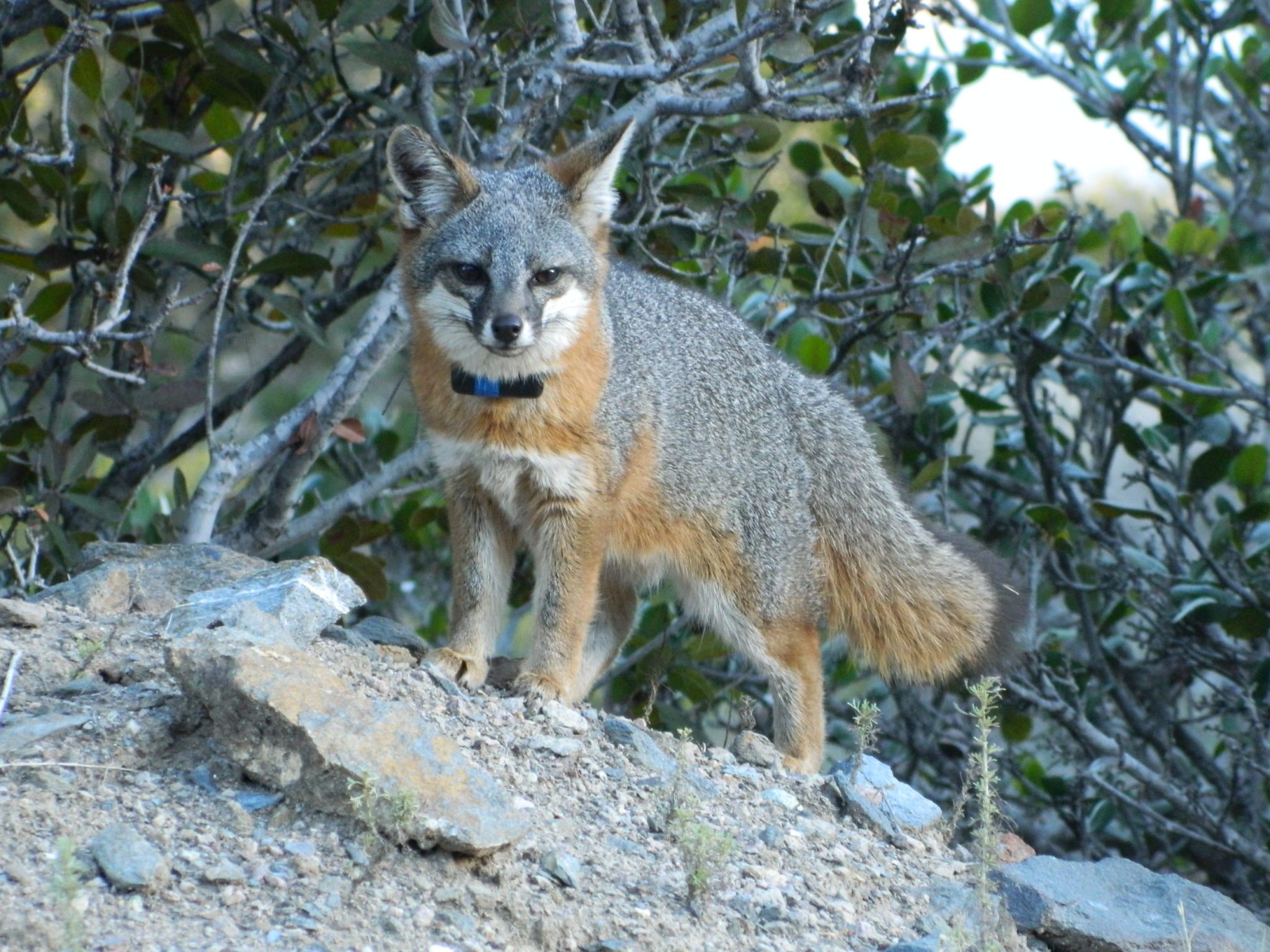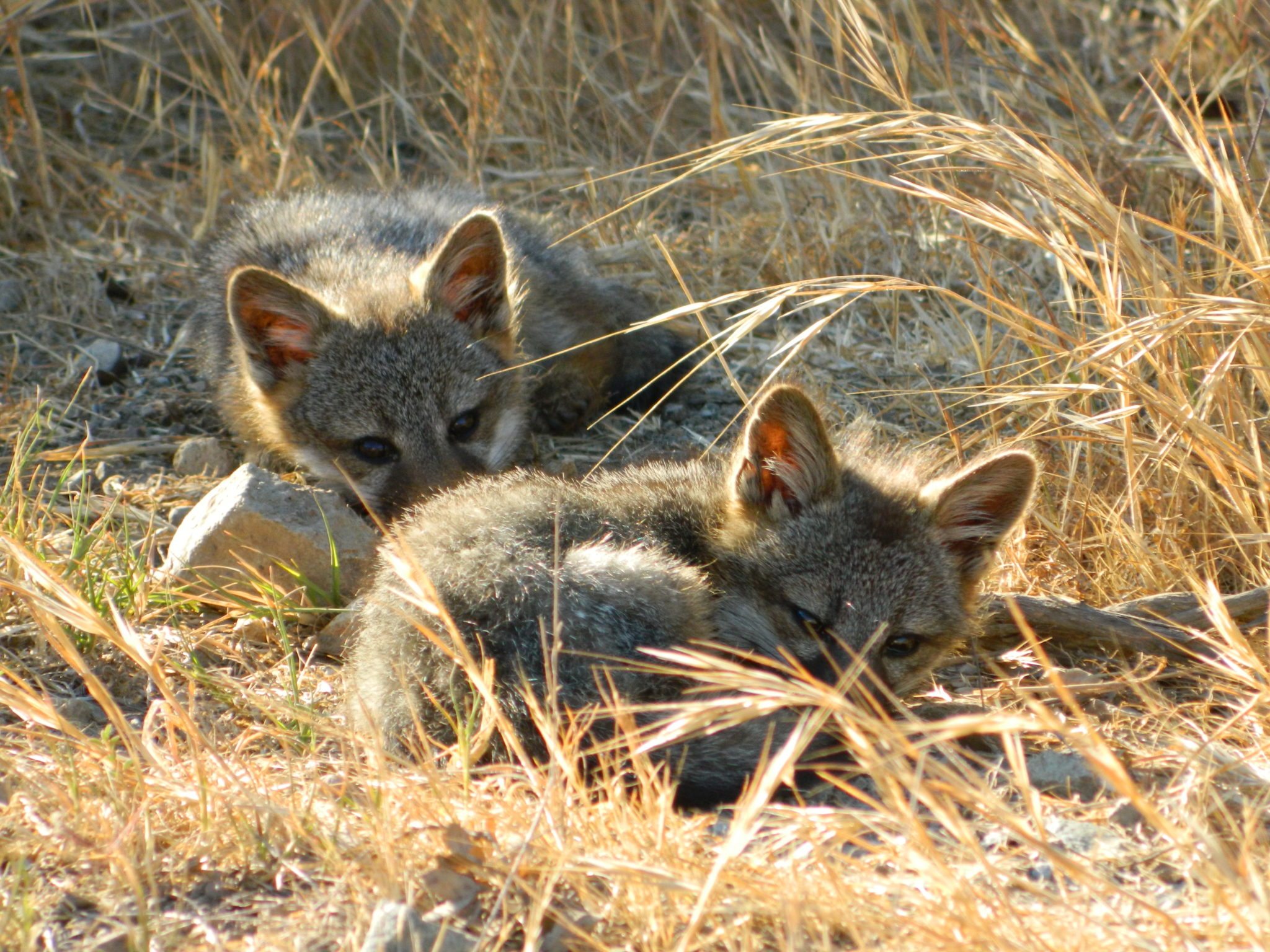Did you know Catalina Island is home to foxes like Tauchi? In 2006, Dave Ohman wrote a story on these foxes in our Coastkeeper Magazine.
Now, we’re proud to feature him as our first guest blogger, to share how Catalina Conservancy is saving and restoring the fox population on the island.
From the brink of extinction, the Catalina Island fox became the come-back story for the ages
In the event you missed our original story in the 2006 edition of Orange County Coastkeeper Magazine, let us briefly fill you in on how this little fox, which arrived about 5,000 years ago (its mode of travel remaining a topic of discussion) nearly went extinct, and what the Catalina Island Conservancy did to bring this species back from the brink. With such a long and impressive history of thriving, it certainly deserved another chance at survival.
Along with establishing a captive breeding program using breeding pairs trapped in the wild, a very successful public awareness campaign was created in 2003 with the help of a fox pup, born at the captive breeding facility but, rejected by her mother, and her litter mates.
After several failed attempts to reunite her with her mother, she was adopted by the team as the go-to, show-and-tell star of the campaign. She was named Tachi and, as she won the hearts and minds of everyone who met her, she became the symbol of the program’s importance to save the Catalina Island fox.
The beguiled included adults, children, politicians and educators, and anyone else with whom she crossed paths. When Tachi made eye contact with you, reaching for your checkbook to help the cause became a natural response.
But, before there was Tachi, a crisis of unimaginable proportions erupted, and disrupted, the wildlife roll call of Catalina.
With the exception of the ubiquitous, scaled-down bison that roam the island, the Catalina Island fox has been as iconic as they come, and the notion that the species could disappear just wasn’t an option within the management team of the Catalina Island Conservancy, and the team of wildlife biologists who took on the challenge to save the fox.

In the course of about a year (1998 -1999), nearly 90 percent of Catalina’s Island foxes had been decimated by a rapidly spreading case of canine distemper virus.
Though one could suspect free-ranging domestic dogs brought ashore by tourists, the real culprit was a non-native raccoon that had somehow made it across the channel to Catalina. But how did it get from the shoreline of the Southern California mainland to Catalina? A long, arduous swim across the romanticized 26 miles was really out of the question. Up to that point, only the famed long-distance swimmer, Florence Chadwick (November 9, 1918 – March 15, 1995) had accomplished such a feat in 1952.
Raccoons, for the uninitiated, are opportunists much like coyotes and bears. And when recreational boats are tied up unattended at a dock, this translates into a late-night hunting-and-gathering mission for a raccoon in search of food, especially if someone forgot to secure the cabin entry to the galley. And the larger the boat, the more cozy sleeping accommodations there are for an exhausted, well-fed raccoon or two.
If by chance the boating party, unaware of this furry stowaway, leaves the dock for a trip to Catalina (a few hours by powerboat, several hours under sail), rest assured, a well-rested, well-fed raccoon will find Avalon much to its liking. Raccoons, after all, are excellent swimmers so, once discovered by horrified boat guests, they will jump ship and swim to shore. And that is the most probable genesis of how Catalina Island foxes nearly met a gruesome end.
As Julie King, Director of Conservation and Wildlife Management for the Catalina Island Conservancy, would tell it, foxes are canines after all and, like dogs in general, they are instinctively inclined to “investigate” scat left about by other critters, likely to confirm if it’s from friend or foe. The unfamiliar raccoon scat was, apparently, more than attractive and curious foxes could not resist. And, given the normal incubation period for distemper of about 21 days, an infected raccoon could transmit the disease exponentially throughout the fox population, which it did.
But how could that happen so quickly?
All scientific evidence seems to indicate that it took but one raccoon to launch the disease. After early fox contact with raccoon scat, the fox scat became a “vehicle” for the exponential spread of the disease. Unlike rabies, which requires physical contact (such as a bite), distemper does not.
Not only is it transferred in feces, which are investigated by foxes, the virus then comes in contact with the mucus membranes of their nose with a good sniff. Then, when foxes meet and greet their family members to exchange licks, or groom each other, saliva and the distemper virus could, in all probability, be exchanged thus accelerating the spread of the disease.
The effects were catastrophic resulting in a population reduction of the Catalina Island fox by 90 percent within one year of the first contact with distemper.
However, the shape of the island, with its narrow isthmus at Two Harbors formed a natural physical bottleneck, and the disease did not cross from the east end to the west end of the island. By trapping healthy breeding pairs on the west end, the captive breeding program and novel ferret distemper vaccine successfully brought this fox back from the brink. While the program has been so successful, the captive breeding facility remained intact, just in case it was required again, until 2016 when it was dismantled.

So how well have the Catalina Island foxes prevailed over such adversity?
To say it has been a remarkably successful recovery may be an understatement. Before releasing the captive breeding couples, each received a microchip, thus allowing biologists using a handheld scanner to identify unique individuals and document fox health, age, dispersal distances, and breeding success over time. About 50 foxes annually are also fitted with radio collars allowing a biologist to track their survival weekly from a plane.
Each year, roughly 300, or so, foxes are trapped and vaccinated against distemper and rabies, with the first inoculation’s efficacy, that is to say, its ability to provide disease protection, lasting about four months. After that, there is an annual booster shot.
Since the population growth of the Catalina Island fox has exceeded expectations to about 1,600 or so, it has been “down-listed” by the U.S. Fish and Wildlife Service, from “endangered” to “threatened.”
Ms. King also noted that the three other endangered island fox subspecies found on San Miguel, Santa Rosa, and Santa Cruz Islands were originally listed as endangered due to golden eagle predation. However, these foxes were officially delisted in August 2016 since all golden eagles were removed from the northern islands several years ago.
Eat prey. Love.
Thanks to the dedicated, and passionate, efforts of the Conservancy’s experienced and passionate wildlife biologists, the Catalina Island fox, with a normal life expectancy of about 10-12 years, is back in circulation across the island in healthy numbers.
This should be a sustainable trend since breeding pairs tend to stay together (though occasional infidelity is not all that uncommon). And while they spend most of their hunting and feasting time on the abundance of native fruit, rodents, reptiles, and bugs, they are as opportunistic and resourceful as raccoons, bears and other adaptable wildlife living near human populations, which makes foraging through local trash and garbage cans an unfortunate convenience.
In fact, Ms. King described this clever fox as “a 5 lb. bear” when it comes to getting into mischief in the garbage. This has resulted in the Conservancy deploying “fox-proof” trash/recycling receptacles throughout the island and wildlife-proof food storage lockers at interior campgrounds to keep foxes safe.
Nearly all Catalina Island residents are aware of the fox’s iconic status, and the need to protect this species from injury and disease.
The recovery from near-extinction of the Catalina Island fox is a tribute to the small, dedicated group of wildlife biologists on the project, the Catalina Island Conservancy, and to the tenacious survival instincts of the fox itself.
To learn more about Catalina Island’s wildlife, for their safety as well as your own, visitors should drop by the Avalon Nature Center to learn the importance of being vigilant while avoiding contact with the fox and other Catalina wildlife.
Through education about the natural world of Catalina Island, well-informed visitors and residents alike will provide an additional margin of protection and safety for all of Catalina’s wildlife thus maintaining this offshore ecological paradise in perpetuity.






